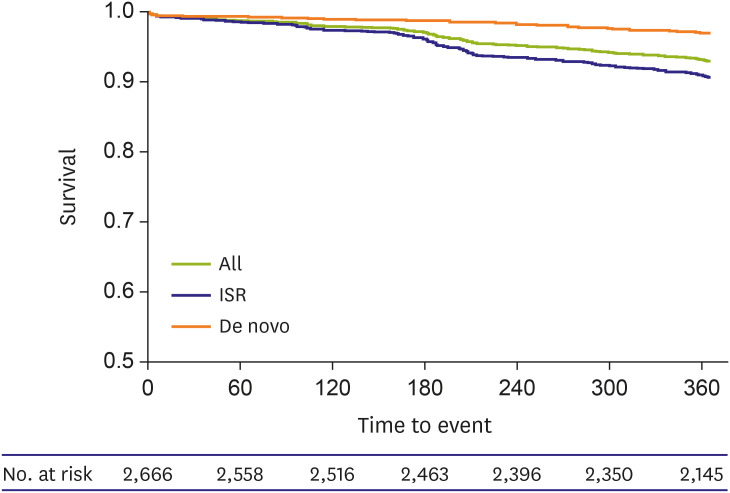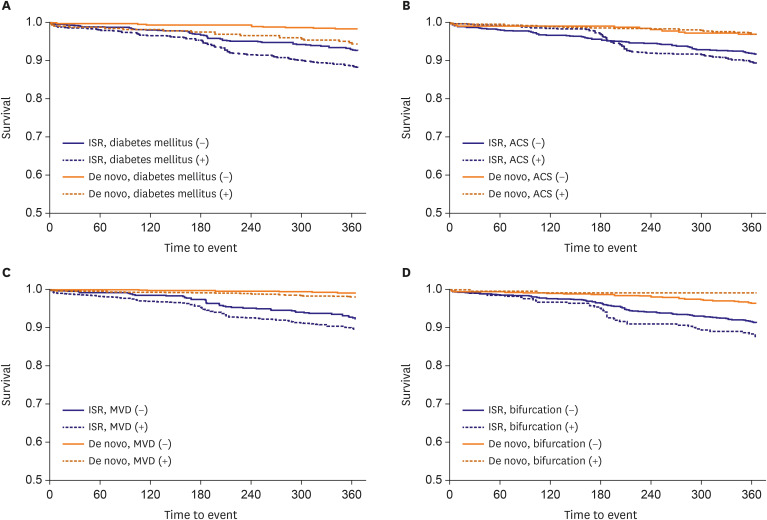Korean Circ J.
2022 Jun;52(6):444-454. 10.4070/kcj.2021.0261.
Clinical Results of Drug-Coated Balloon Treatment in a Large-Scale Multicenter Korean Registry Study
- Affiliations
-
- 1Division of Cardiology, Chung-Ang University Gwangmyeong Hospital and Department of Internal Medicine, ChungAng University College of Medicine, Gwangmyeong, Korea
- 2Department of Cardiology, Keimyung University Dongsan Hospital, Daegu, Korea
- 3Department of Internal Medicine, Chung-Ang University Hospital, Chung-Ang University College of Medicine, Seoul, Korea
- 4Department of Internal Medicine, Chonnam National University Hospital, Chonnam National University College of Medicine, Gwangju, Korea
- 5Department of Internal Medicine, Seoul National University Hospital, Seoul National University College of Medicine, Seoul, Korea
- 6Department of Internal Medicine, Chungbuk National University Hospital, Chungbuk National University College of Medicine, Cheongju, Korea
- 7Department of Internal Medicine, Wonju Severance Christian Hospital, Yonsei University, Wonju College of Medicine, Wonju, Korea
- 8Department of Internal Medicine, Inje University Busan Paik Hospital, Inje University College of Medicine, Busan, Korea
- 9Department of Internal Medicine, Kyungpook National University Hospital, Kyungpook National University School of Medicine, Daegu, Korea
- 10Department of Internal Medicine, Chungnam National University Hospital, Chungnam National University College of Medicine, Daejeon, Korea
- 11Department of Internal Medicine, Korea University Anam Hospital, Korea University College of Medicine, Seoul, Korea
- 12Department of Internal Medicine, Kyung Hee University Medical Center, Kyung Hee University College of Medicine, Seoul, Korea
- 13Department of Internal Medicine, Gyeongsang National University Changwon Hospital, Gyeongsang National University School of Medicine, Changwon, Korea
- 14Bucheon Sejong Hospital, Bucheon, Korea
- 15Incheon Saint Mary's Hospital, Incheon, Korea
- 16Department of Internal Medicine, Ulsan University Hospital, Ulsan University College of Medicine, Ulsan, Korea
- 17Department of Internal Medicine, Yeungnam University Medical Center, Yeungnam University College of Medicine, Daegu, Korea
- 18Department of Internal Medicine, Dong-A University Hospital, Dong-A University College of Medicine, Busan, Korea
- 19Department of Cardiology, Inje University Haeundae Baek Hospital, Inje University College of Medicine, Busan, Korea
- KMID: 2530449
- DOI: http://doi.org/10.4070/kcj.2021.0261
Abstract
- Background and Objectives
The aim of this study was to demonstrate the efficacy and safety of treatment with drug-coated balloon (DCB) in a large real-world population.
Methods
Patients treated with DCBs were included in a multicenter observational registry that enrolled patients from 18 hospitals in Korea between January 2009 and December 2017. The primary outcome was target lesion failure (TLF) defined as a composite of cardiovascular death, target vessel myocardial infarction, and clinically indicated target lesion revascularization at 12 months.
Results
The study included 2,509 patients with 2,666 DCB-treated coronary artery lesions (1,688 [63.3%] with in-stent restenosis [ISR] lesions vs. 978 [36.7%] with de novo lesions). The mean age with standard deviation was 65.7±11.3 years; 65.7% of the patients were men. At 12 months, the primary outcome, TLF, occurred in 179 (6.7%), 151 (8.9%), 28 (2.9%) patients among the total, ISR, and de novo lesion populations, respectively. A history of hypertension, diabetes, acute coronary syndrome, previous coronary artery bypass graft, reduced left ventricular ejection fraction, B2C lesion and ISR lesion were independent predictors of 12 months TLF in the overall study population.
Conclusions
This large multicenter DCB registry study revealed the favorable clinical outcome of DCB treatment in real-world practice in patient with ISR lesion as well as small de novo coronary lesion.
Keyword
Figure
Cited by 1 articles
-
Drug-Coated Balloons for Unselected Real World Patients: Are We There Yet?
Fernando Alfonso, Bernardo Cortese
Korean Circ J. 2022;52(6):455-459. doi: 10.4070/kcj.2022.0108.
Reference
-
1. Palmerini T, Benedetto U, Biondi-Zoccai G, et al. Long-term safety of drug-eluting and bare-metal stents: evidence from a comprehensive network meta-analysis. J Am Coll Cardiol. 2015; 65:2496–2507. PMID: 26065988.2. Gada H, Kirtane AJ, Newman W, et al. 5-year results of a randomized comparison of XIENCE V everolimus-eluting and TAXUS paclitaxel-eluting stents: final results from the SPIRIT III trial (clinical evaluation of the XIENCE V everolimus eluting coronary stent system in the treatment of patients with de novo native coronary artery lesions). JACC Cardiovasc Interv. 2013; 6:1263–1266. PMID: 24239202.
Article3. Yamaji K, Räber L, Zanchin T, et al. Ten-year clinical outcomes of first-generation drug-eluting stents: the Sirolimus-Eluting vs. Paclitaxel-Eluting Stents for Coronary Revascularization (SIRTAX) VERY LATE trial. Eur Heart J. 2016; 37:3386–3395. PMID: 27578808.
Article4. Scheller B, Hehrlein C, Bocksch W, et al. Treatment of coronary in-stent restenosis with a paclitaxel-coated balloon catheter. N Engl J Med. 2006; 355:2113–2124. PMID: 17101615.
Article5. Windecker S, Kolh P, Alfonso F, et al. 2014 ESC/EACTS guidelines on myocardial revascularization. EuroIntervention. 2015; 10:1024–1094. PMID: 25187201.
Article6. Buccheri D, Piraino D, Andolina G, Cortese B. Understanding and managing in-stent restenosis: a review of clinical data, from pathogenesis to treatment. J Thorac Dis. 2016; 8:E1150–E1162. PMID: 27867580.
Article7. Alfonso F, Scheller B. State of the art: balloon catheter technologies - drug-coated balloon. EuroIntervention. 2017; 13:680–695. PMID: 28844030.
Article8. Kleber FX, Rittger H, Bonaventura K, et al. Drug-coated balloons for treatment of coronary artery disease: updated recommendations from a consensus group. Clin Res Cardiol. 2013; 102:785–797. PMID: 23982467.
Article9. Neumann FJ, Sousa-Uva M, Ahlsson A, et al. 2018 ESC/EACTS Guidelines on myocardial revascularization. Eur Heart J. 2019; 40:87–165. PMID: 30165437.10. Wöhrle J, Zadura M, Möbius-Winkler S, et al. SeQuentPlease World Wide Registry: clinical results of SeQuent please paclitaxel-coated balloon angioplasty in a large-scale, prospective registry study. J Am Coll Cardiol. 2012; 60:1733–1738. PMID: 23040575.11. Yerasi C, Case BC, Forrestal BJ, et al. Drug-coated balloon for de novo coronary artery disease: JACC state-of-the-art review. J Am Coll Cardiol. 2020; 75:1061–1073. PMID: 32138967.12. Jeger RV, Farah A, Ohlow MA, et al. Drug-coated balloons for small coronary artery disease (BASKET-SMALL 2): an open-label randomised non-inferiority trial. Lancet. 2018; 392:849–856. PMID: 30170854.13. Latib A, Colombo A, Castriota F, et al. A randomized multicenter study comparing a paclitaxel drug-eluting balloon with a paclitaxel-eluting stent in small coronary vessels: the BELLO (Balloon Elution and Late Loss Optimization) study. J Am Coll Cardiol. 2012; 60:2473–2480. PMID: 23158530.
Article14. Cortese B, Di Palma G, Guimaraes MG, et al. Drug-coated balloon versus drug-eluting stent for small coronary vessel disease: PICCOLETO II randomized clinical trial. JACC Cardiovasc Interv. 2020; 13:2840–2849. PMID: 33248978.
Article15. Jeger RV, Eccleshall S, Wan Ahmad WA, et al. Drug-coated balloons for coronary artery disease: third report of the International DCB Consensus Group. JACC Cardiovasc Interv. 2020; 13:1391–1402. PMID: 32473887.16. Thygesen K, Alpert JS, Jaffe AS, et al. Fourth universal definition of myocardial infarction (2018). Eur Heart J. 2019; 40:237–269. PMID: 30165617.
Article17. Onuma Y, Serruys PW, Perkins LE, et al. Intracoronary optical coherence tomography and histology at 1 month and 2, 3, and 4 years after implantation of everolimus-eluting bioresorbable vascular scaffolds in a porcine coronary artery model: an attempt to decipher the human optical coherence tomography images in the ABSORB trial. Circulation. 2010; 122:2288–2300. PMID: 20975003.
Article18. Wykrzykowska JJ, Kraak RP, Hofma SH, et al. Bioresorbable scaffolds versus metallic stents in routine PCI. N Engl J Med. 2017; 376:2319–2328. PMID: 28402237.
Article19. Chen Y, Gao L, Qin Q, et al. Comparison of 2 different drug-coated balloons in in-stent restenosis: the RESTORE ISR China randomized trial. JACC Cardiovasc Interv. 2018; 11:2368–2377. PMID: 30522665.20. Habara S, Kadota K, Shimada T, et al. Late restenosis after paclitaxel-coated balloon angioplasty occurs in patients with drug-eluting stent restenosis. J Am Coll Cardiol. 2015; 66:14–22. PMID: 26139053.
Article21. Lee HS, Kang J, Park KW, et al. Procedural optimization of drug-coated balloons in the treatment of coronary artery disease. Catheter Cardiovasc Interv. 2021; 98:E43–E52. PMID: 33491857.22. Park KW, Lee JM, Kang SH, et al. Safety and efficacy of second-generation everolimus-eluting Xience V stents versus zotarolimus-eluting resolute stents in real-world practice: patient-related and stent-related outcomes from the multicenter prospective EXCELLENT and RESOLUTE-Korea registries. J Am Coll Cardiol. 2013; 61:536–544. PMID: 23273394.23. Kelley-Hedgepeth A, Lloyd-Jones DM, Colvin A, et al. Ethnic differences in C-reactive protein concentrations. Clin Chem. 2008; 54:1027–1037. PMID: 18403563.
Article
- Full Text Links
- Actions
-
Cited
- CITED
-
- Close
- Share
- Similar articles
-
- Endoscopic Papillary Large Balloon Dilation: Guidelines for Pursuing Zero Mortality
- Drug-Coated Balloon Treatment for De Novo Coronary Lesions: Current Status and Future Perspectives
- No-Reflow Phenomenon During Treatment of Coronary In-Stent Restenosis With a Paclitaxel-Coated Balloon Catheter
- Drug-Coated Balloon Treatment for De Novo Coronary Artery Disease
- The past, present, and future of research on anaphylaxis in Korean children



